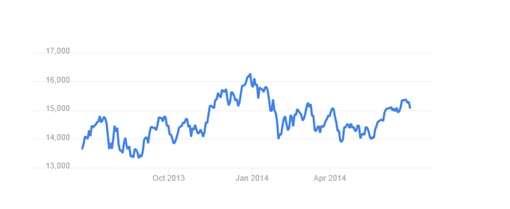 Below you’ll find a chart that covers one year in the life of the Nikkei 225, concluding June 27, 2014.
Below you’ll find a chart that covers one year in the life of the Nikkei 225, concluding June 27, 2014.
It is worth a look if only because AIMA Japan and Eurekahedge together have surveyed Japanese investors and found, among much else, that respondents plan to maintain the present size of their allocations to hedge funds, and that they believe Nikkei could go to 20,000 this year.
The investors surveyed (130) have more than $3.8 trillion in assets. They say that the average percentage of their alternative-investments going to hedge funds will be 72.5% in 2014, which is just what it was in 2013.
Changing Vehicles, Shifting Geography
This doesn’t amount to a national case of stand-patism. Investors plan to reduce their exposure to CTA/managed futures funds, macro funds, and those pursuing fixed income strategies. But those moves will be balanced by increased exposure to long/short equity and event driven strategies.
Looking at their portfolios geographically, Japanese investors expect to raise their exposure to global, Asia ex-Japan and Middle East/Africa focused funds, pulling back in their exposure to those with mandates for Latin America and Europe. Their exposure at home, in Japan, will continue at the present level.
Most of the investors in the survey expressed positive views about the Japanese economy. Almost 90% regard the policies of the incumbent Prime Minister, Shinzo Abe, favorably. Seventy two percent expect that the Nikkei will finish 2014 above 15,000.

Here, as promised, is the recent (one year) move of the Nikkei. As you can see there was a wave of optimism late last year, which brought the index from roughly 13,500 late in the third quarter to above 16,000 at year’s end.
But … it is difficult to believe that a positive attitude toward Abenomics is also the cause of any more recent surge, because that soufflé has already collapsed. As you can also see above, sentiment turned quite sharply, and the Nikkei has tested the 14,000 level repeatedly this year, though each time finding resistance there. The latest move has brought it up to 15,000.
Skepticism About Abe and Alleged Abe-ophilia
What is Abenomics and who might not love it? The Prime Minister’s latest administration (he has held the office before, with undistinguished results) is associated with, on the monetary side, the targeting of a 2% inflation rate, the maintenance of negative interest rates, and quantitative easing. Meanwhile on the fiscal side, Abe presses for more spending, referred to (as is the international custom these days) as public investment, and he has pressed for higher taxes. His program also incorporates supply-side deregulatory policies and some reform of the Bank of Japan Act.
We at AllAboutAlpha had previously had reason to observe that both Japanese equities and Japanese mandated hedge funds performed in mediocre fashion (and that is generous wording) through the first quarter of 2014. Nonetheless, Keynesians love him. After all, if you take Keynesian assumptions as gospel, then you are likely to believe that Japanese culture, a culture in which thrift is deeply respected, is part of the problem.
Furthermore, if you understand that the Japanese are smart enough to know what a cheapening of a currency means, mathematically, you’ll expect that many will be wary of an erosion of savings kept in that currency. So you won’t be surprised that there is push-back against that idea, push-back that one can call “cultural” if one is so inclined.
Keynesians, then, write a script according to which far-sighted statesmen like Abe have to break down that dangerous cultural love of savings, and get money out of the mattresses and into circulation.
Such a notion is, frankly, jejune, and the demise of the academic consensus in its favor is one of the more fortunate developments of recent decades. It is a bad script, and it has had a part in too many bad movies.
Some Backing Off
But Abe himself may have been backing off of the Abenomics hashtags in recent weeks. He said on June 24th that there are no “sacred cows” for his growth strategy – which sounds as if he’s signaling his admirers not to hang all their admiration on, say, that 2% target.
According to a Reuters poll, most economists say the inflation rate won’t get to the targeted level without further yen-cheapening measures. The present inflation rate is only 0.8% after adjusting for the effects of the hike in the consumption tax rate, and the Bank of Japan seems reluctant to push the matter much further.
It is possible, then, that the recent uptick in animal in animal spirits in Japan comes largely from a sense that Abenomics as originally conceived has run its course, and that Abe and the rest of the gang there will have to move on shortly.



